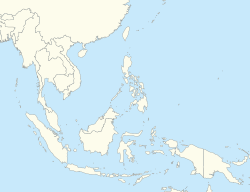Maʼya is an Austronesian language of the Raja Ampat islands in Southwest Papua, Indonesia. It is part of the South Halmahera–West New Guinea (SHWNG) subgroup and is spoken by about 6,000 people in coastal villages on the islands Misool, Salawati, and Waigeo,[2] on the boundary between Austronesian and Papuan languages.[3]
| Maʼya | |
|---|---|
| Native to | Indonesia |
| Region | Raja Ampat Islands |
Native speakers | 5,000 (2000–2001)[1] |
| Language codes | |
| ISO 639-3 | Variously:slz – Ma'yakgb – Kawelcc – Legenyemwuy – Wauyai |
| Glottolog | raja1258 |
| ELP | Legenyem |
 | |
| Coordinates: 0°52′S 130°39′E / 0.86°S 130.65°E | |
Dialects
editMaʼya has five dialects: three on the island of Waigeo (Laganyan, Wauyai, and Kawe), one on Salawati, and one on Misool.[4] The prestige dialect is the one on Salawati.[citation needed] The varieties spoken on Salawati and Misool are characterized by the occurrence of /s/ and /ʃ/ in some words, where the Waigeo dialects (and other related SHWNG languages) have /t/ and /c/ respectively.[2]
On Waigeo Island, the three dialects are[5]: 6
- The Kawe dialect in Selpele and Salyo villages in the northwest part of the island.
- The Laganyan dialect is spoken in Araway, Beo, and Luptintol villages on the Mayalibit Bay coast.
- The Wauyai/Wawiyai dialect is spoken in Wawiyai village on the Kabui Bay coast.
Phonology
editConsonants
edit| Labial | Alveolar | Palatal | Velar | Glottal | ||
|---|---|---|---|---|---|---|
| Plosive | voiceless | p | t | k | (ʔ) | |
| voiced | b | d | ɡ | |||
| Nasal | m | n | (ŋ) | |||
| Fricative | f | s | ||||
| Tap | ɾ | |||||
| Lateral | l | |||||
| Approximant | w | j | ||||
- Twelve consonants may also be heard as palatalized /pʲ, bʲ, tʲ, dʲ, kʲ, ɡʲ/; /fʲ, sʲ/; /mʲ, nʲ, lʲ, wʲ/.
- When in word-final position, six plosives can occur as unreleased [p̚, b̚, t̚, d̚, k̚, ɡ̚], as well as nasals [m̚, n̚, ŋ̚].
- /l/ can be heard as retroflex [ɭ] in word-final positions, and when preceded by a back vowel.
- /s/ can be pronounced as [ʃ] when between two /i/ vowel sounds.
- /ɾ/ can also be heard as a trill [r], when in word-final positions.
- /n/ can be heard as a velar [ŋ], when preceding velar stops. [ŋ] may also be a loan phoneme.
- The glottal stop [ʔ] is heard mostly phonetically, in word-initial position before initial vowels.
- Other sounds /ɦ, x, z/ may also occur as a result of Arabic and Indonesian loanwords.
Vowels
edit| Front | Central | Back | |
|---|---|---|---|
| Close | i | u | |
| Mid | e | ɔ | |
| Open | a | ||
| Phoneme | Allophones |
|---|---|
| /e/ | [e], [e̝], [ɛ] |
| /a/ | [a], [ä] |
| /ɔ/ | [ɔ], [ɔ̞], [o] |
- Other sounds /ɪ, ʊ/ are considered archiphonemes, and can also phonetically occur as a result of /i, u/ within vowel clusters.[6]
Tone
editIn Maʼya both tone and stress are lexically distinctive.[2][7] This means both the stress and the pitch of a word may affect its meaning. The stress and tone are quite independent from one another, in contrast to their occurrence in Swedish and Serbo-Croatian. The language has three tonemes (high, rising and falling). Out of over a thousand Austronesian languages, there are only a dozen with lexical tone; in this case it appears to be a remnant of shift from Papuan languages.
Lexical tone is found only in final syllables.[8]
See also
edit- Matbat language, a neighboring language with more extreme Papuan influence and five tones.
References
edit- ^ Ma'ya at Ethnologue (18th ed., 2015) (subscription required)
Kawe at Ethnologue (18th ed., 2015) (subscription required)
Legenyem at Ethnologue (18th ed., 2015) (subscription required)
Wauyai at Ethnologue (18th ed., 2015) (subscription required) - ^ a b c Remijsen, Bert (2001). "Dialectal Variation in the Lexical Tone System of Ma'ya". Language and Speech. 44 (4): 473–499. doi:10.1177/00238309010440040301. PMID 12162695.
- ^ Remijsen, Bert (November 2003), "New Perspectives in Word-Prosodic Typology" (PDF), IIAS Newsletter #32, p. 29, archived from the original (PDF) on 2011-06-11
- ^ Arnold, Laura (2018). "A preliminary archaeology of tone in Raja Ampat". In Antoinette Schapper (ed.). Contact and substrate in the languages of Wallacea, Part 2. NUSA Vol. 64. pp. 7–37.
- ^ Arnold, Laura Melissa (2018). Grammar of Ambel, an Austronesian language of Raja Ampat, west New Guinea (PhD). University of Edinburgh. hdl:1842/31120.
- ^ van der Leeden, Alex C. (1993). Maʼya: a language study. Seri Terbitan LIPI-RUL Jakarta: Lembaga Ilmu Pengetahuan Indonesia and Rijkuniversiteit te Leiden.
- ^ Rivera-Castillo, Yolanda; Pickering, Lucy (2004). "Phonetic Correlates of Stress and Tone in a Mixed System". Journal of Pidgin and Creole Languages. 19 (2): 261–284. CiteSeerX 10.1.1.538.9834. doi:10.1075/jpcl.19.2.02riv.
- ^ Arnold, Laura. 2018. ‘A preliminary archaeology of tone in Raja Ampat’. In Antoinette Schapper, ed. Contact and substrate in the languages of Wallacea, Part 2. NUSA 64: 7–37. doi:10.5281/zenodo.1450778
Further reading
edit- van der Leeden, Alex (1993). Maʼya: Phonology. Lembaga Ilmu Pengetahuan Indonesia. p. 97. ISBN 9789798258015.
